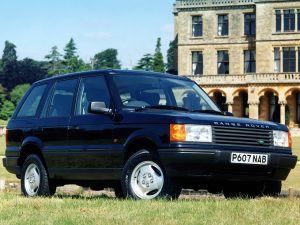Recalls: Land Rover P38A Range Rover
Overview
Manufacturers, or importers, issue recalls for defects or faults which have the potential to cause injury. Generally, manufacturers will inform the original buyers if their vehicle is subject to a recall and of the steps required to remedy the defect or fault. Please note that the recalls below (if any) are for Australian-delivered vehicles only. Furthermore, the number of recalls should not be taken as an indication of a model’s reliability or its safety more generally.
Recalls: Land Rover P38A Range Rover
- In July 1995, a recall was issued for Land Rover P38A Range Rover vehicles that were manufactured from March 1995 to April 1995 and in the VIN range LP311035 to LP312917. In these vehicles, the ABS high pressure hoses may fracture, resulting in the loss of power brakes (PRA 1995/2514).
- In October 1995, a recall was issued for Land Rover P38A Range Rover vehicles due to potential failure of the engine idler pulley which could damage the drive belt and cause the loss of power assisted steering and ancillary component drive (PRA 1995/2605).
- In March 1996, a recall was issued for Land Rover P38A Range Rover vehicles manufactured from June 1994 to March 1995. In these vehicles, the rear radius arm – which located the rear axle – could fail at the extruded aluminium chassis eye end due to stress corrosion cracking and/or a cold weld. A broken radius arm could allow movement of the rear axle and vehicle instability (PRA 1996/2776).
- In August 1998, a recall was issued for Land Rover P38A Range Rover vehicles that were manufactured from 1995 to 1998 and in the VIN range MA 300190 to WW 402293. In these vehicles, the cooling system hoses could fail prematurely. If the water content of the coolant were to evaporate, traces of the coolant in contact with hot engine components could ignite (PRA 1998/3633).
- In March 1999, a recall was issued for Land Rover P38A Range Rover vehicles manufactured from June 1994 to August 1998 and with serial numbers in the range MA300000 to XA410482. In these vehicles, the end of the automatic transmission breather pipe may ‘ice up’ in sub-zero ambient temperatures. This could cause transmission fluid from the dipstick tube to be expelled onto hot engine components, potentially resulting in an under-bonnet fire (PRA 1999/3854).
- In November 1999, a recall was issued for P38A Range Rover vehicles that were manufactured between July 1998 to September 1999 and with VINs in the range XA410483 to YA429903. In these vehicles, the power steering pump pulley may fail at low kilometres due to fatigue cracks. If this occurred, the serpentine drive belt would also be damaged, resulting in loss of power steering, electrical charging and vehicle cooling (PRA 1999/4158).
- In May 2001, a recall was issued for P38A Range Rover vehicles that were manufactured between June 1998 and December 2000. In these vehicles, water ingress into the automatic gearbox breather pipe could corrode the park lock function. By rendering the lock inoperative, the vehicle may roll away when stationary (PRA 2001/4727).
- In June 2001, a recall was issued for P38A Range Rover vehicles that were manufactured between October 1994 and August 1998 (inclusive). In these vehicles, the cooling system hoses could fail prematurely when subjected to elevated temperatures. If the water content of the coolant were to evaporate, traces of the coolant in contact with hot engine components could ignite (PRA 2001/4627).
- In August 2001, a recall was issued for P38A Range Rover vehicles that were manufactured between September 1998 and January 1999. In these vehicles, a cooling system gasket located below the throttle body housing may leak and expel fluid onto hot engine components (PRA 2001/4600).
Problems and faults: Land Rover P38A Range Rover
Overview
This section identifies potential problems, causes and fixes based on the experiences of owners and repairers, online sources and technical service bulletins. This information is provided solely for reference purposes and AustralianCar.Reviews recommends that only properly qualified persons carry out repairs or modifications. Furthermore, the number of items below should not be taken as an indicator of a model’s reliability or the frequency with which they may occur.
To report a problem or fault to the AustralianCar.Reviews team, please use the Contact Us form. Note that AustralianCar.Reviews does not offer advice on automotive problems or disputes; such enquiries will not receive a reply. For vehicles purchased from dealers after 1 January 2011, please see our Australian Consumer Law fact sheet.
Problems and faults: Land Rover P38A Range Rover
- The cruise control system may fail due to leaks in the ends of the vacuum lines connected to the throttle actuator; the problem is easily repaired by replacing the rubber vacuum tubing.
- The pollen filters should be replaced according to schedule (every 50,000 km) or even every 15,000 if the vehicle is driven in dusty conditions. Failure to replace the filters puts strain on the air conditioning blower motors and can cause the relay terminals in the engine compartment fusebox to burn out.
- Electrical errors (including ‘Gearbox Fault’ warnings) may be caused by bad electrical grounds or bad batteries.
- The Electronic Air Suspension (EAS) system uses long-travel Dunlop air springs. However,
- the air springs can develop slow leaks at the top and bottom with the passing of time;
- a valve block in the compressor enclosure includes a solenoid valve for each spring and other control valves to regular air flow. This is the most expensive component in the EAS system and must be replaced if the valves start leaking; and,
- the air compressor can also wear out.




